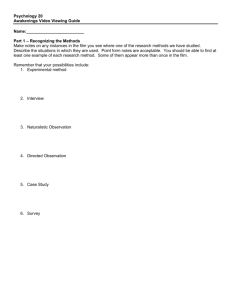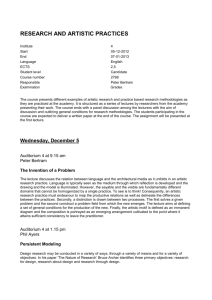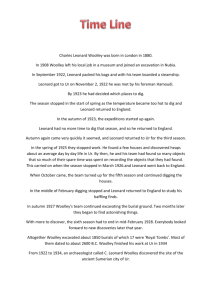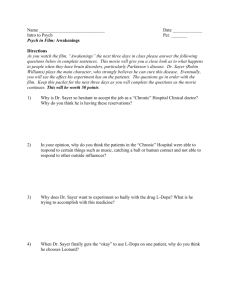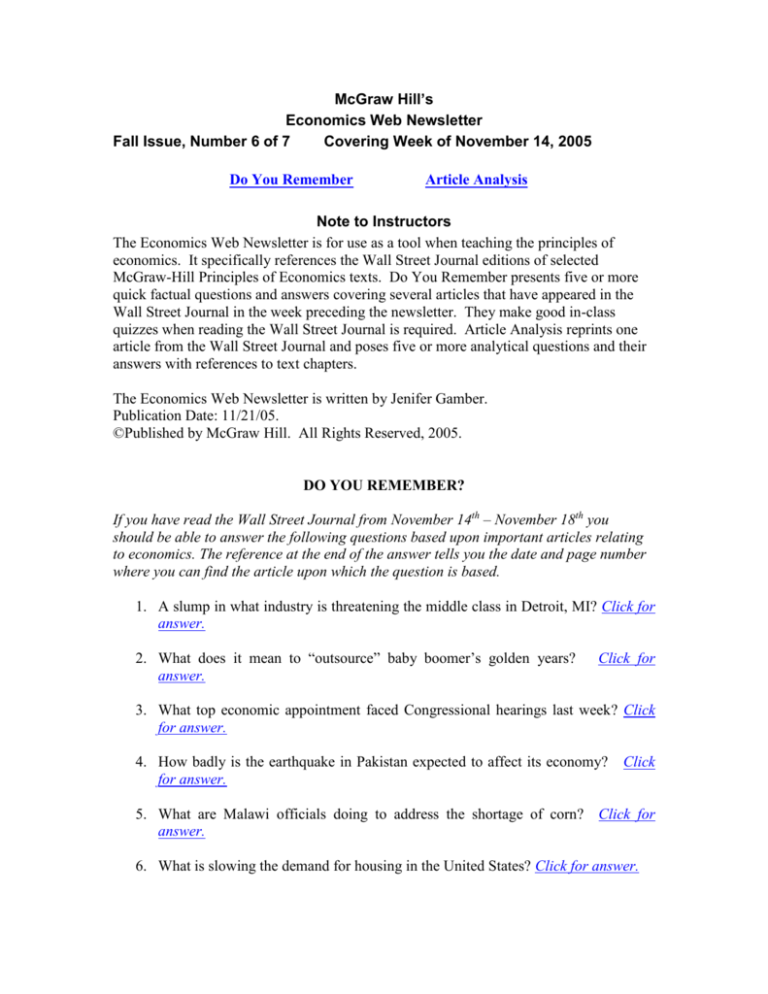
McGraw Hill’s
Economics Web Newsletter
Fall Issue, Number 6 of 7
Covering Week of November 14, 2005
Do You Remember
Article Analysis
Note to Instructors
The Economics Web Newsletter is for use as a tool when teaching the principles of
economics. It specifically references the Wall Street Journal editions of selected
McGraw-Hill Principles of Economics texts. Do You Remember presents five or more
quick factual questions and answers covering several articles that have appeared in the
Wall Street Journal in the week preceding the newsletter. They make good in-class
quizzes when reading the Wall Street Journal is required. Article Analysis reprints one
article from the Wall Street Journal and poses five or more analytical questions and their
answers with references to text chapters.
The Economics Web Newsletter is written by Jenifer Gamber.
Publication Date: 11/21/05.
©Published by McGraw Hill. All Rights Reserved, 2005.
DO YOU REMEMBER?
If you have read the Wall Street Journal from November 14th – November 18th you
should be able to answer the following questions based upon important articles relating
to economics. The reference at the end of the answer tells you the date and page number
where you can find the article upon which the question is based.
1. A slump in what industry is threatening the middle class in Detroit, MI? Click for
answer.
2. What does it mean to “outsource” baby boomer’s golden years?
answer.
Click for
3. What top economic appointment faced Congressional hearings last week? Click
for answer.
4. How badly is the earthquake in Pakistan expected to affect its economy?
for answer.
Click
5. What are Malawi officials doing to address the shortage of corn? Click for
answer.
6. What is slowing the demand for housing in the United States? Click for answer.
7. In the past few years are Americans facing a higher or lower tax burden? Click for
answer.
8. What does Fed Chairman Alan Greespan believe the government can do to
address the huge trade deficit? Click for answer.
9. Were there more or fewer labor strikes this year compared to last year? Click for
answer.
10. Does Ben Bernanke, nominee for Fed Chairman support inflation targeting? Click
for answer.
ANSWERS TO “DO YOU REMEMBER?” QUESTIONS
1. Auto industry. (See “A Middle Class Made by Detroit Is Now Threatened by Its
Slump” November 14, page A1.)
2. Some developing countries are luring retiring baby boomers to relocate to their
countries, hoping their big spending follows them. (See “Developing Nations
Lure Retirees, Raising Idea of 'Outsourcing' Boomers' Golden Years” November
14, page A2)
3. Ben Bernanke, nominee for the chairman of the Fed. (See “Bernanke to Face
Questions About Inflation, Deficit” November 14, page A2)
4. It is expected to lower economic growth, but only slightly. (See “Pakistani
Economy To Withstand Quake” November 14, A21)
5. Encourage consumers to substitute other crops in their diet. (See “It's White,
Gloppy, Almost Tasteless, And Malawi Loves It” November 15, page A1)
6. Higher mortgage rates, talk of a housing bubble and higher home heating costs.
(See “Housing Market Shows Further Signs of Cooling” November 15, page A1)
7. Greater. (See “Tax Burden Is Rising, Survey Finds” November 15, page A2)
8. Nothing. Market forces will likely correct it. (See “Greenspan Sees No Policy
Edge To Fix Trade Gap” November 15, page A2)
9. More. (See “Strikes Multiply Amid Increase In Labor Fights” November 15, page
B1)
10. Yes. (See “Bernanke Affirms His Support For Specific Inflation Target”
November 16, page A2)
Return to Questions
Made in Washington
How the Textile Industry Alone
Won Quotas on Chinese Imports
An Obscure Beltway Agency
Can Dictate Terms of Trade;
Implications for Diplomacy
Mr. Leonard's Homecoming
By GREG HITT
Staff Reporter of THE WALL STREET JOURNAL
November 10, 2005; Page A1
WASHINGTON -- In the past four years, U.S. industries from mattress-spring makers to
wire-coat-hanger manufacturers have requested federal protection from surges in Chinese
imports. Only one has received it: textiles.
To understand one reason why, peek inside the third floor of the Herbert Hoover
building, a stone fortress around the corner from the White House and home to the
Committee for the Implementation of Textile Agreements.
This obscure corner of the federal bureaucracy, known as CITA
(pronounced SEE-ta), has in the past year imposed trade barriers on
a range of Chinese goods from shirts to dressing gowns to manmade fiber underwear. The U.S. government is broadly worried
about China, from the tight grip it maintains on its currency to the
problem of piracy. But CITA is a notable example of the U.S.
directly challenging its new rival. As such, it shows how a powerful
industry lobby can have a big effect on foreign policy.
Few American industries enjoy such a dedicated bureaucratic focus
in Washington -- and such a powerful one. CITA's founding charter
gives it unilateral power to impose limits on textile imports. Its
actions are final. Its deliberations are exempt from public disclosure
on the grounds that they have foreign-policy implications. Until recently, CITA
publicized its decisions only through filings in the Federal Register, the government's
daily notice of administrative actions.
James C. Leonard III, CITA's chairman and a textile-company veteran, says the agency
weighs all sides in making its decisions, but allows that it has a protectionist bent. CITA's
core mission, as he describes it, is "trying to help maintain a domestic manufacturing
industry."
1. Illustrate the effect of import restrictions (quotas) on the domestic price of
textiles.
The impact of CITA's decisions on U.S. consumers is considerable. Chinese
manufacturers produce apparel at lower cost than their U.S. competitors because of their
economies of scale and low-priced labor. Import limits therefore tend to lead to higher
domestic prices as apparel companies scramble to hook up with new -- and often more
expensive -- suppliers elsewhere in Asia and Central America.
CITA's power has grown in recent months. Mr. Leonard helped lead a team of U.S.
government officials negotiating a textile trade pact with China. The talks were sparked
by the agency's own imposition of sanctions. At a ceremony in London this week, the
U.S. and China inked a pact that imposes controls on Chinese access to American
markets through 2008. CITA will enforce the rules set under the agreement. Its main
weapon is its ability to restrict imports.
2. How do economies of scale and low-priced labor lead to higher priced textiles
from China?
Richard Nixon created CITA in the midst of his 1972 re-election campaign at a time
when the U.S. textile industry was under pressure from Japan and Taiwan. The president
was wooing Southern textile barons to make Republican inroads in the region, much as
the current Republican administration is concerned about protecting those gains as it
pursues its own trade policy. CITA is now buried within the Commerce Department's
sprawling D.C. bureaucracy, where 20,000 workers consider patent requests, plot
strategies to restore salmon stocks and catalogue statistics about life in America.
The five-member panel is charged with overseeing a regime of regulations governing
global textile trade. It has wide discretion over how quotas should be enforced and
whether new ones should be slapped on. Its members are drawn from the Labor, Treasury
and State departments, as well as the Office of the U.S. Trade Representative, an arm of
the White House.
The Treasury and State departments have opposed
import curbs over the years, according to people
familiar with the debates. The Treasury
Department, which has long had a free-trade bent,
even boycotted meetings in the 1990s in protest of
the group's protectionist leanings, says a former
CITA member.
But Commerce is the lead agency. With its mission
to promote domestic industry, it has set a tone
sympathetic to producers. By tradition, the
Commerce Department's CITA seat has been filled
by a political appointee with ties to the textile
industry. That seat also brings with it the committee's chairmanship.
Dan Ikenson, a trade-policy specialist at the Cato Institute, a free-market think tank that
opposes the use of import restrictions, likens CITA's proceedings to a "kangaroo court."
Referring to its decisions, he says "to expect objectivity...is expecting something
miraculous."
Mr. Leonard, 66 years old, is officially the deputy assistant secretary for textiles and
apparel. He has a staff of more than 30 analysts who report to him and an office looking
out on the Washington Monument.
His previous job was as an economist and trade advocate for North Carolina textile giant
Burlington Industries Inc. In that post, he used the company's jet to fly Commerce
staffers, including those from the office he now oversees, to tour company plants in the
Carolinas. He also knows personally the pain of import competition. As Burlington slid
into bankruptcy protection in 2001, Mr. Leonard was among the thousands of employees
to lose their jobs.
He continues to wear American-stitched suits, though the last one he bought "was made
of imported fabric," he says with a shrug.
Shortly after President Bush took office in 2001, a Commerce official recruited Mr.
Leonard for the CITA chairmanship. Mr. Leonard jumped at the chance. His great uncle,
Luther Hodges -- himself a long-time textile executive -- had been President Kennedy's
commerce secretary. His portrait hangs in the halls of the Hoover building.
3. What accounts for the difference of opinion between the State and Treasury
Departments and the Commerce Department? What would be some reasons the
Commerce Department cites in support of restrictions?
'A Balancing Act'
But Mr. Leonard's three decades in an industry wedded to protectionism met with
ambivalence within the administration. A White House personnel officer grilled him
about whether he'd be able to work for a president with a free-trade platform, Mr.
Leonard recalls. "It's going to be a balancing act," Mr. Leonard says he responded. "I
have to look at things from both sides now."
He took office at a time of mounting worries about China. The Nixon-era quotas that had
regulated global textile sales were being slowly phased out and would expire entirely at
the end of 2004. China had just won entry to the World Trade Organization, which
allowed it for the first time to take advantage of international free-trade rules.
In addition to these economic issues, the U.S. government, in particular the Pentagon,
was starting to view China and its growing military sophistication with increasing
suspicion. Sino-U.S. relations were rapidly moving to the top of the diplomatic agenda.
To avoid a sudden, disruptive flood of Chinese products into the American market, the
U.S. negotiated with Beijing special provisions allowing for the possibility of "safeguard"
trade barriers in the event of an import "surge." The safeguards would be permitted
through 2008 for textiles, 2013 for other goods.
For most products, complaints were routed through the International Trade Commission,
a government body that investigates and makes recommendations to the White House,
which makes the final decision. For textiles, the decision was left to Mr. Leonard and
CITA.
True to his promise to skeptics in the Bush administration, Mr. Leonard was not an
automatic rubber-stamp for industry demands. Through 2002, he rebuffed textile makers'
calls to use the newly negotiated agreement to place limits on imports whose quotas had
expired. He insisted first on codifying CITA's historically opaque procedures.
Mr. Leonard set guidelines and timetables as part of the process of imposing restraints.
Companies would need hard import and production data to back up their contentions. Mr.
Leonard says it was important to add transparency to a process that could have big
implications for U.S. foreign policy. "We'd never done anything like this before," he says,
referring to his revamp of CITA.
The delay in considering new limits infuriated Mr. Leonard's old textile colleagues. "We
got very annoyed," says National Textile Association President Karl Spilhaus, who
knows Mr. Leonard well. "We were pounding on him." Industry lobbyists met repeatedly
in private with Mr. Leonard in the first half of 2003. They wanted to pressure him to take
action and also explain the new rules for filing protection requests.
By the end of 2003, having set up the new CITA system, Mr. Leonard was ready to
respond. He proposed that CITA impose new limits on certain Chinese imports.
In early discussions, the State and Treasury departments opposed the move. Labor and
Commerce were supportive, while USTR was undecided, according to current and former
administration and industry officials.
Public-Relations Campaign
Mr. Leonard's hand was strengthened by a public-relations campaign launched by an old
friend, Augustine Tantillo, executive director of the American Manufacturing Trade
Action Coalition, a lobbying group formed by more than a dozen industry executives. Mr.
Tantillo is also a former CITA chairman.
Mr. Tantillo and other lobbyists issued a widely distributed report asserting that China
was poised to gain control of up to 75% of the U.S. apparel market. "What we did in the
industry was say, 'let's build pressure to such a massive extent' " that CITA is forced to
impose new limits, Mr. Tantillo says.
That helped steer the holdouts on CITA toward Mr. Leonard's proposal. An
administration official says the government worried about getting "killed" politically by
the textile industry's congressional allies if CITA rejected the petitions. In December
2003, Mr. Leonard won unanimous approval for 12-month import limits on Chinesemade bras, dressing gowns and knit fabric. CITA cited a big jump in shipments including
a 1,484% increase in dressing gowns between 2000 and 2003.
Top Chinese officials objected strongly and called in the U.S. ambassador in Beijing for
emergency meetings to protest the actions.
For the textile industry, that was just the beginning. Facing the Dec. 31, 2004, expiration
of the last of the world-wide quotas, textile-makers began pushing for pre-emptive action.
Instead of asking for protection from actual increases in imports, they wanted CITA to
impose limits before such a rise, based merely on the anticipation of one. A lawsuit from
importers and retailers blocked that line of attack.
4. Why would retailers lobby against import restrictions?
After that rebuff, the industry turned to CITA, contending it was already being hurt by
cheap imports. Under Mr. Leonard's new rules, it would take more than six months for
any new restrictions to kick in. That was too long for Mr. Tantillo. "Rome is burning," he
says he warned Mr. Leonard.
Mr. Tantillo began urging Mr. Leonard to install an early-warning system highlighting
increases in imports. But there were hurdles. Computers at the Customs Bureau had to be
specially programmed to spit out the requested numbers. The Census Bureau, which
massages data for public consumption, didn't want to release data it hadn't properly
studied. Yet Mr. Tantillo knew from his own Commerce Department days that the data
could be retrieved. "This is what they do for a living, they collect numbers and put them
in a chart," he says.
Mr. Leonard and his staff started crafting a new set of numbers from the raw shipping
data collected by Customs. They developed a computer program to cross-check the
figures, looking for anomalies that might point to reporting errors, for example.
By March, the Commerce Department announced the creation of the new reporting
system that accelerated the release of import data by weeks. The special data set showed
that Chinese imports in the first quarter of 2005, compared with the year-earlier period,
had risen more than 1,000% for cotton knit shirts, blouses and cotton trousers; and more
than 300% for man-made fiber underwear.
On May 13, almost three months ahead of its regular schedule, CITA announced a plan to
impose limits.
The Chinese bristled at CITA's actions, as did U.S. retailers and importers who were
counting on buying products from China. Mr. Leonard, however, is unapologetic, citing
the growth in imports. "We felt completely justified," he says.
Write to Greg Hitt at greg.hitt@wsj.com
5. Who is hurt by import quotas? Looking at your text (Colander) what is the cost of
each U.S. apparel job saved by trade restrictions?
ANSWERS TO ARTICLE ANALYSIS QUESTIONS
Refer to chapter 21 Colander’s Economics, and Microeconomics for help when answering
these questions.
Refer to chapters 6 and 37 in McConnell’s Economics and chapters 6 and 24 in
Microeconomics for help when answering these questions.
Cost
1. The effect of quotas on domestic price and quantity sold is shown in the graph
below. Without any imports, the price would be $3. Without any quotas domestic
price would be $2 and domestic producers would sell Q0. With the quota shown,
the domestic producers sell a higher quantity Q1 at a higher price $2.50.
Domestic
Demand
Domestic
Supply
$3.00
$2.50
World supply w/quota
$2.00
World supply w/o quota
Quota
Q0 Q1
.
Return to article.
2. Economies of scale mean that Chinese manufacturers are able to lower their longrun average total costs by producing greater quantities. This, along with lower labor
costs, means that Chinese manufacturers spend less to produce their goods, and are
therefore willing to sell their textiles at lower prices. Return to article.
3. It’s difficult to say. It appears that the Commerce Department has historical ties to
domestic industries that would make it sympathetic to the concerns of domestic
producers. It is possible that the State Department and Treasury follow the lead of
the administration, which is more pro free-trade, more closely. The Commerce
Department’s arguments to support import restrictions would be to save American
jobs. They might argue that China doesn’t trade fairly (perhaps its environmental
protections are too low). They may argue that the U.S. would also enjoy greater
economies of scale in the production of textiles when import restrictions expand
U.S. production. These cost savings would be passed along to consumers. They
might also argue that the costs of transitioning employees dislocated by trade to
different industries is too high. Return to the article.
4. Imports lower the cost of goods paid by retailers allowing them to sell their goods
at a lower price or alternatively earn greater profits. Return to article.
5. Consumers are hurt by import quotas because they have to pay higher product
prices. According to the table on page 496 of Colander’s Economics, each job
saved in the apparel industry costs $297,550 per year. Return to article.




